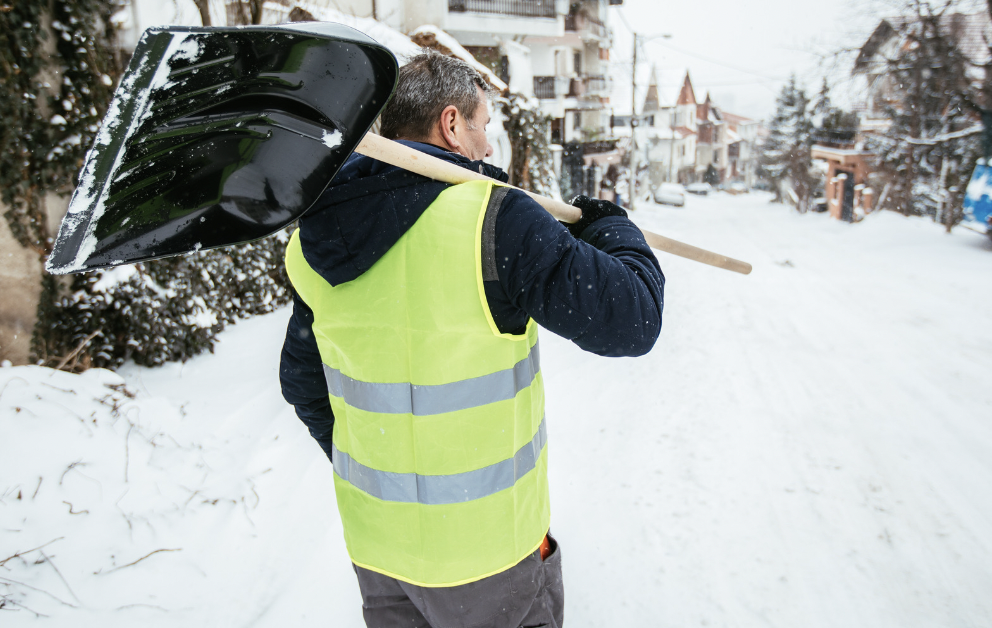Winter is upon. And with it comes snow sprinkled evergreens, dark, cozy evenings, and a warm fireplace for the luckiest among us.
Oh, and freezing temperatures, 6:00am shoveling, and impossibly icy sidewalks.
These downsides of winter are a hassle for many of us. And for seniors, they can be extremely dangerous.
Read on to learn about the risks of winter for seniors, and 3 tips to follow for a safer season.
1. Be mindful of low temperatures
Extremely cold weather can be dangerous for anyone.
With age, the body’s ability to adjust to the cold (and heat) decreases. Age-related fat loss, medical conditions and medication impact its ability to control temperature.
As such, age increases the risk of hypothermia. This happens when the core body temperature drops below 95 degrees.
Hypothermia usually happens after exposure to extreme cold, but can also occur after a short time, or in cool weather (40+ degrees).
Hypothermia
Early signs
- Cold feet and hands
- Shivering
- Tiredness
- Confusion
- Irritated mood
- Swollen face
- Pale skin
Late signs
- Uncontrollable twitching of the limbs
- Slow heartbeat
- Shallow breathing
- Loss of consciousness
Preventing hypothermia
Indoors
- Keep the thermostat between 68 and 70 degrees
- Wear warm indoor clothes, incl. socks/slippers, long underwear, etc.
- Eat a healthy diet so the body has enough energy to make heat
- If possible, winterize the house (block drafts, have insulation checked, etc.)
- If living alone, ask family and friends to check in regularly
Outdoors
- Don’t stay outside too long
- Wear a hat that covers the ears, mittens (they allow fingers to share heat better than gloves), a scarf that covers the neck, face and mouth, and boots
- Wear at least three layers of loose fitting, warm clothing. This helps trap body heat better than one thick, tight-fitting layer.
- Change wet clothes immediately
- Don’t drink alcohol. It causes heat loss.
- If traveling by car, keep an emergency winter kit in the vehicle
Frostbite
Seniors are also at a higher risk for frostbite.
Frostbite is damage to the skin and tissue caused by freezing temperatures.
It happens in stages:
Stage 1: Frostnip
- Cold skin
- Pins and needles
- Numbness in the affected area
- Can be fixed by rewarming the area. It doesn’t cause permanent damage.
Stage 2: Superficial frostbite
- Small change in skin color
- Affected area may start to feel warm
- Rewarming the area can cause blotchy skin
- A blister may appear 12 to 36 hours after rewarming
Stage 3: Deep frostbite
- All layers of the skin and the tissue below are affected
- Skin may turn white or gray
- No sensation in affected area
- Affected joints/muscles may stop working
- Skin hardens and turns black as the tissue dies
Superficial and deep frostbite are medical emergencies and need to be treated by a doctor.
Preventing frostbite
The tips noted above for preventing hypothermia outdoors are the same for frostbite.
Additionally, if there are signs of frostnip, get to a warm place before the condition progresses.
2. Understand how shoveling affects the heart
A movie trope: a stalwart older man insists on shoveling his snowy driveway and unexpectedly dies of a heart attack.
This happens in real life, too.
In cold weather, blood vessels tighten. This may affect how much blood the heart gets. Also, to keep warm, circulation increases. This is also demanding for the heart.
When paired with shoveling, an intense exercise, this can cause shortness of breath and chest pain.
Shoveling can also cause plaque to detach inside the arteries. This can block blood flow, causing a heart attack.
Heart symptoms/attacks are most common for people with existing heart conditions. But healthy people may be affected, too.
Signs of a heart attack
- Chest, neck, upper back, and left arm discomfort/pain (it may be constant, or come and go, called “stuttering”)
- Cold sweats
- Nausea
- Fast heartbeat or palpitations
- Chest tightness
- Dizziness
- Difficulty breathing
- Intense arm pain
To prevent shoveling-related heart symptoms:
- Exercise regularly throughout the year. An active lifestyle helps prevent heart disease.
- Know personal risk of heart disease
- Push snow out of the way, rather than scooping and moving it. This takes less effort.
3. Prevent falls on ice
For those of us who live in places that reach 32 degrees or below, ice can be a real hazard.
Slippery, frozen surfaces make walking outdoors more risky.
In general, seniors have a higher risk of falling. This is caused by balance issues and bone/muscle weakness. Vision issues, medications, and other health conditions can also increase risk.
Falls can cause serious injury, like head trauma, breaks and fractures, and increased bleeding due to weaker blood vessels.
To prevent winter falls:
- Wear appropriate shoes with good treads and ice grippers, if needed
- Keep walkways clear of snow and ice
- Be cautious. Check for ice before stepping and avoid unmaintained areas.
- Bring sand or cat litter to toss on slippery spots. This provides better grip.
- Take short, shuffling steps (like a penguin), instead of quick, large ones
Summary
Winter can be a time for cozy clothes, lovely holidays, and beautifully snowy landscapes.
It can also pose some hazards, especially for seniors.
But with proper preparation, seniors can stay warm, healthy, and injury-free.
Struggling with the seasons changing? Learn more about seasonal affective disorder.
Sources


